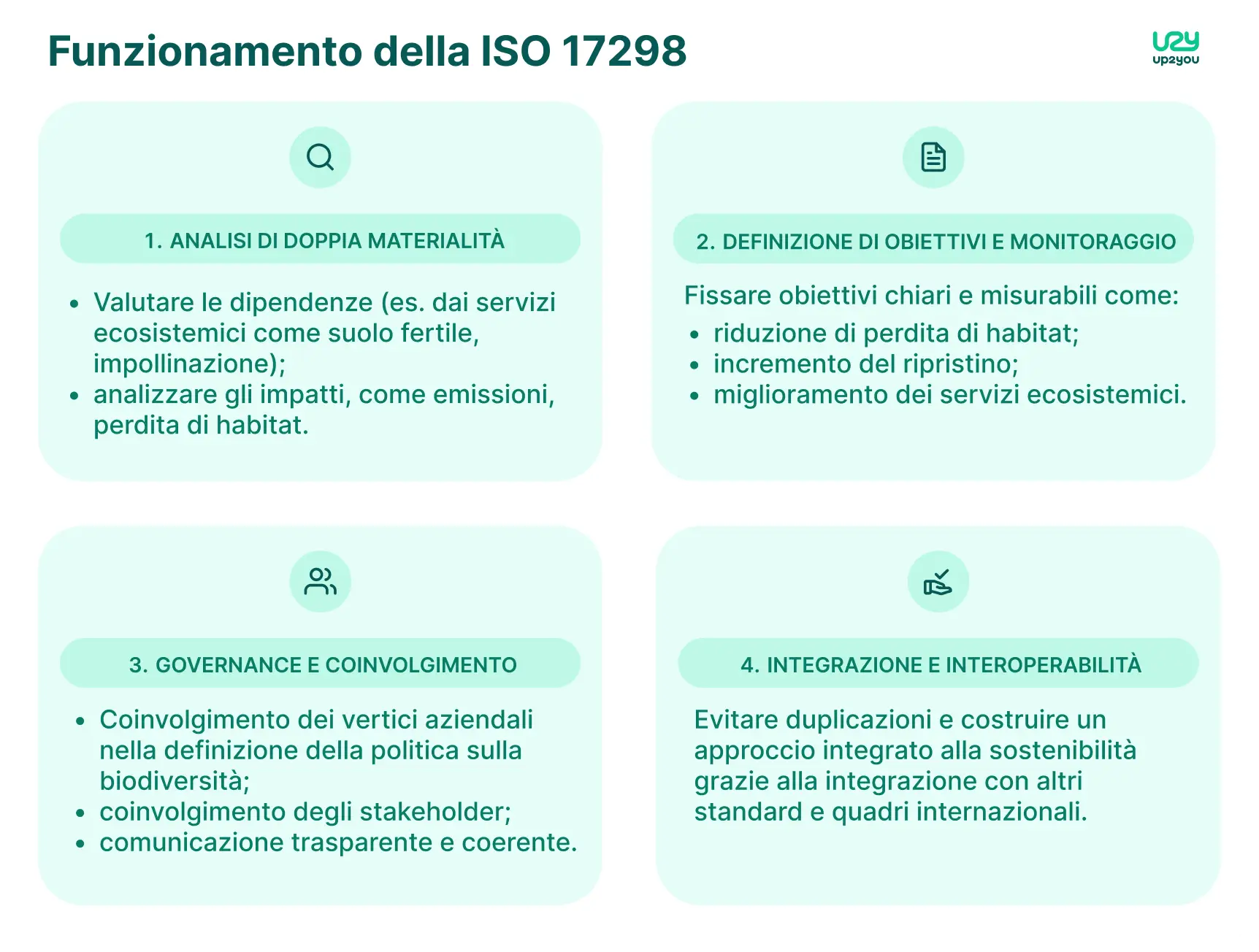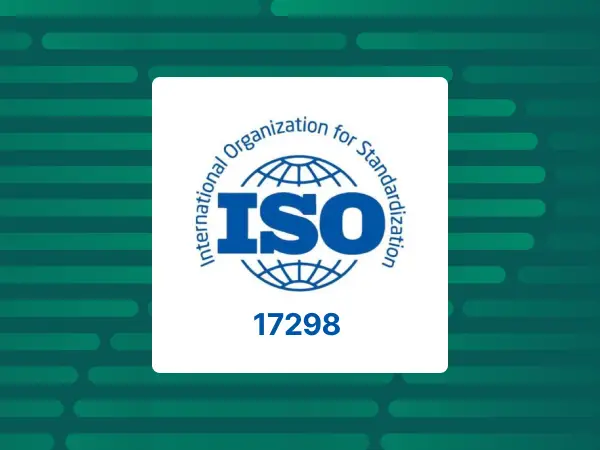{summary#bullet-1}
What is ISO 17298
La ISO 17298 It's a sustainability certification And the first international standard that helps organizations integrate the protection of biodiversity in their strategies and daily operations.
Presented in October 2025, during the ISO's annual meeting in Kigali, Rwanda, this standard was created with the aim of providing a global and practical technical framework to measure, manage and reduce business impacts on nature.
Biodiversity, the variety of life on the planet, is fundamental to the well-being of ecosystems, economies and communities. However, its accelerated loss jeopardizes the environmental and social balance.
In this context, ISO 17298 represents a concrete and scalable tool that allows companies to Move from analysis to action, evaluating and managing its relationship with natural capital in a structured way.
In practice, the standard allows you to:
- evaluate impacts and dependencies along the value chain;
- identify risks and opportunities related to biodiversity;
- integrate the protection of nature into governance, operations and corporate finance;
- define measurable objectives, indicators and concrete action plans;
- improve transparency and reporting to stakeholders.
Developed by experts from more than 60 Countries, the standard was designed to be interoperable with other major international standards and initiatives, such as:
- ISO 14001 (environmental management);
- ISO 26000 (corporate social responsibility);
- the TNFD (Taskforce on Nature-related Financial Disclosures);
- and the United Nations Sustainable Development Goals (SDGs).
ISO 17298 also contributes to the Kunming—Montreal Global Biodiversity Framework, in particular to Objective 15, which encourages companies to monitor, evaluate and communicate their impacts and actions in favor of nature in a transparent way.
Biodiversity is also the theme of the next edition of Up2You Green Cup. Click the button below to find out what it's all about and how to participate.
{summary#bullet-2}
Who is ISO 17298 for
The ISO 17298 standard has been designed to be widely applicable, regardless of size, sector and nature of the institution (public or private). In particular, it is useful for:
- large companies who operate on complex markets and supply chains and who seek a global framework to integrate biodiversity into governance, risk management and operations;
- SMES who need a scalable and gradual approach to incorporate nature protection into existing processes;
- public bodies and non-profit organizations interested in standardizing metrics, processes and objectives in line with the main international references.
So let's understand how ISO 17298 addresses any organization, big or small, public or private, whatever evaluate their dependencies and impacts on biodiversity, identify risks and opportunities related to natural capital and transform this analysis into concrete and measurable actions aimed at promoting a concrete corporate sustainability.
Thanks to this wide applicability, ISO 17298 is not a commitment reserved only for multinationals: it represents a concrete opportunity also for leaner realities who want to anticipate regulatory trends, strengthen their resilience and contribute credibly to an economy that promotes sustainability as a business pillar.
{summary#bullet-3}
How does ISO 17298 work
La Norma ISO 17298 is divided into requirements and guidelines that help companies to transform environmental awareness into concrete and measurable action. Let's see what are the steps to take to obtain ISO 17298.
1. Double materiality analysis
First, the standard invites organizations to activate a double materiality analysis. On the one hand, the internal materiality, or how business activities impact on nature, on the other hand the external materiality, or how nature itself supports, or not, business activities.
In concrete terms, it means:
- Evaluate addictions, for example from ecosystem services such as fertile soil, clean water, pollination;
- analyze the impacts, such as emissions, habitat loss, alteration of biological cycles.
This framework makes it possible to identify not only risks (operational, reputational, financial) but also opportunity related to the transition to a “nature-positive” model.
2. Definition of objectives and monitoring
Once impacts, dependencies, risks and priorities have been defined, ISO 17298 encourages the organization to set clear and measurable objectives Like:
- reduction of habitat loss;
- increased recovery;
- improvement of ecosystem services.
In parallel, it requires a monitoring and reporting system. It is not enough to intervene, it is necessary to demonstrate documentable progress towards the objectives, promoting transparency and accountability to stakeholders.
3. Governance and engagement
The standard is not just a list of environmental indicators: it requires that biodiversity come integrated into corporate governance, in decision-making processes, in risk management and in strategy.
It means that the top management, the board of directors or similar bodies, must be involved in the definition of biodiversity policy, and that there is an involvement of internal and external stakeholders, as well as transparent and consistent communication.
4. Integration and interoperability
An additional key element is that ISO 17298 is designed to be compatible and integrable with other international standards and frameworks already adopted, such as ISO 14001 on environmental management, ISO 26000 on social responsibility, the Taskforce on Nature-related Financial Disclosures (TNFD) and the Sustainable Development Goals (SDGs).
In this way, organizations can avoid duplication and build an integrated approach to sustainability, in which the protection of nature becomes an integral part of the strategy ESG overall.

{summary#bullet-4}
The 6 advantages for companies of obtaining ISO 17298
Obtaining and putting into practice ISO 17298 is not just a ethical choice, is a concrete lever of competitiveness, resilience and reputation. Here are the 6 most significant advantages for businesses.
1. Reduced risks and a more resilient supply chain
The standard makes it visible addictions and impacts on nature, helping to prevent supply interruptions, increased raw material costs and litigation. This allows for fewer operational surprises and greater business continuity.
2. Access to green finance and better conditions
Data credible and comparable on biodiversity they strengthen dialogue with investors and banks, opening access to “nature-positive” tools and improving ESG rating, cost of capital and attractiveness for strategic partnerships.
3. Alignment with regulatory and stakeholder requirements
Integration with global frameworks (e.g. GBF, SDG, TNFD) facilitates conformity to disclosure and emerging obligations, reducing sanctioning risks and proactively responding to the expectations of customers, supply chain leaders and local communities.
4. Stronger governance and better decisions
Biodiversity enters decision-making processes (board, risk management, planning), with measurable goals, monitoring and reporting. This improves accountability, decision-making speed and the ability to manage trade-offs between costs, risks and opportunities.
5. Operational efficiency and integration with other systems
ISO 17298 is interoperable with ISO 14001/26000 and ESG framework, avoiding duplication and streamlining audits, metrics and information flows. It derives from it process efficiency, cost optimization and internal clarity of roles.
6. Competitive advantage
Bringing verifiable “nature-positive” results differentiates the brand, improves attracting talent and customers, ability to innovate product/service and reinforces the Social license to operate in the territories.

























